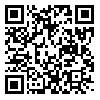Volume 16, Issue 3 (Vol.16, No.3 2020)
irje 2020, 16(3): 257-265 |
Back to browse issues page
Download citation:
BibTeX | RIS | EndNote | Medlars | ProCite | Reference Manager | RefWorks
Send citation to:



BibTeX | RIS | EndNote | Medlars | ProCite | Reference Manager | RefWorks
Send citation to:
Tanhaye Reshvanloo F, Sedaghatee S, Kareshki H, Saeidi Rezvani T. Validation of the Persian Version of a Scale for Screening Internet Anxiety in Students. irje 2020; 16 (3) :257-265
URL: http://irje.tums.ac.ir/article-1-6664-en.html
URL: http://irje.tums.ac.ir/article-1-6664-en.html
1- PhD Student in Educational Psychology, Department of Counseling and Educational Psychology, Faculty of Educational Sciences and Psychology, Ferdowsi University of Mashhad, Mashhad, Iran , farhadtanhay@um.ac.ir
2- BSc in Psychology, Department of Psychology, Faculty of Educational Sciences and Psychology, Ferdowsi University of Mashhad, Mashhad, Iran
3- Associate Professor in Educational Psychology, Department of Counseling and Educational psychology, Faculty of Educational Sciences and Psychology, Ferdowsi University of Mashhad, Mashhad, Iran
2- BSc in Psychology, Department of Psychology, Faculty of Educational Sciences and Psychology, Ferdowsi University of Mashhad, Mashhad, Iran
3- Associate Professor in Educational Psychology, Department of Counseling and Educational psychology, Faculty of Educational Sciences and Psychology, Ferdowsi University of Mashhad, Mashhad, Iran
Abstract: (1915 Views)
Background and Objectives: The widespread use of the Internet has created new issues in the field of psychological studies. One of these emerging constructs is Internet anxiety. The purpose of the present study was to investigate the construct validity of the Internet Anxiety Scale in students.
Methods: In a descriptive, validation study, 206 and 289 students from Farhangian University Branches of Mashhad were selected through multi-stage sampling and completed the Internet Anxiety Scale and Internet Self-efficacy scale, respectively. Internal consistency, exploratory and confirmatory factor analysis, criterion and constructive validity were evaluated using SPSS.25 and AMOS.24 software.
Results: The results showed that the scale had a two-factor structure with an explained variance of 55.82%. Confirmatory factor analysis was confirmed. The scale had good construct reliability. The divergent validity confirmed in relation to Internet self-efficacy (P<0.01). There was no significant difference in age (P>0.05). Gender differences were significant for fear of negative evaluation (F=6.53, P<0.01) and internet anxiety score (F=7.22, P<0.01), and girls had higher mean scores. Differences were significant according to field (P <0.01) and Science and Foreign Language students had the lowest and the highest mean score, respectively (21.37 and 27.05).
Conclusion: It seems that the Internet Anxiety Scale has a good reliability and validity in students.
Methods: In a descriptive, validation study, 206 and 289 students from Farhangian University Branches of Mashhad were selected through multi-stage sampling and completed the Internet Anxiety Scale and Internet Self-efficacy scale, respectively. Internal consistency, exploratory and confirmatory factor analysis, criterion and constructive validity were evaluated using SPSS.25 and AMOS.24 software.
Results: The results showed that the scale had a two-factor structure with an explained variance of 55.82%. Confirmatory factor analysis was confirmed. The scale had good construct reliability. The divergent validity confirmed in relation to Internet self-efficacy (P<0.01). There was no significant difference in age (P>0.05). Gender differences were significant for fear of negative evaluation (F=6.53, P<0.01) and internet anxiety score (F=7.22, P<0.01), and girls had higher mean scores. Differences were significant according to field (P <0.01) and Science and Foreign Language students had the lowest and the highest mean score, respectively (21.37 and 27.05).
Conclusion: It seems that the Internet Anxiety Scale has a good reliability and validity in students.
Type of Study: Research |
Subject:
Epidemiology
Received: 2021/01/6 | Accepted: 2020/11/30 | Published: 2020/11/30
Received: 2021/01/6 | Accepted: 2020/11/30 | Published: 2020/11/30
Send email to the article author
| Rights and permissions | |
 |
This work is licensed under a Creative Commons Attribution-NonCommercial 4.0 International License. |





